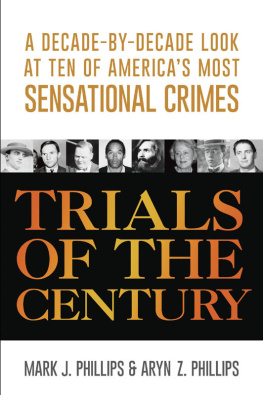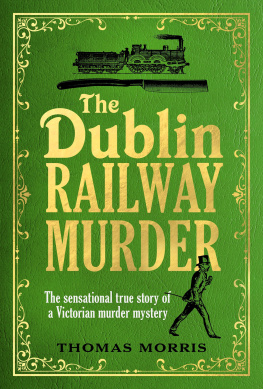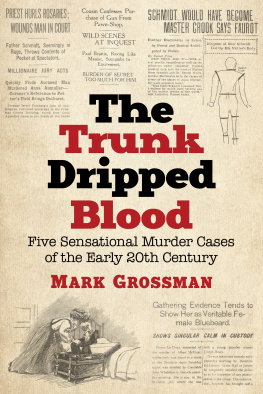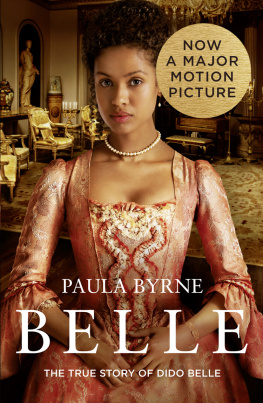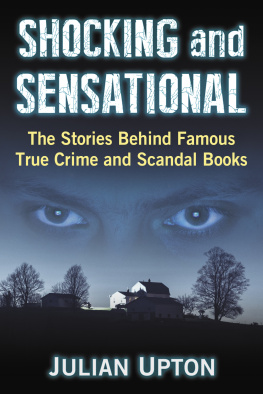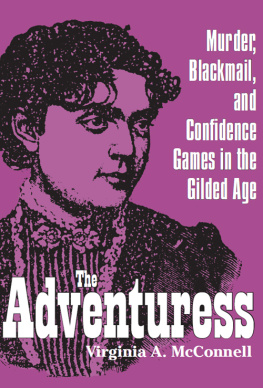TRUE CRIME HISTORY
Twilight of Innocence: The Disappearance of Beverly Potts James Jessen Badal
Tracks to Murder Jonathan Goodman
Terrorism for Self-Glorification: The Herostratos Syndrome Albert Borowitz
Ripperology: A Study of the Worlds First Serial Killer and a Literary Phenomenon Robin Odell
The Good-bye Door: The Incredible True Story of Americas First Female Serial Killer to Die in the Chair Diana Britt Franklin
Murder on Several Occasions Jonathan Goodman
The Murder of Mary Bean and Other Stories Elizabeth A. De Wolfe
Lethal Witness: Sir Bernard Spilsbury, Honorary Pathologist Andrew Rose
Murder of a Journalist: The True Story of the Death of Donald Ring Mellett Thomas Crowl
Musical Mysteries: From Mozart to John Lennon Albert Borowitz
The Adventuress: Murder, Blackmail, and Confidence Games in the Gilded Age Virginia A. McConnell
Queen Victorias Stalker: The Strange Case of the Boy Jones Jan Bondeson
Born to Lose: Stanley B. Hoss and the Crime Spree That Gripped a Nation James G. Hollock
Murder and Martial Justice: Spying, Terrorism, and Retribution in Wartime America Meredith Lentz Adams
The Christmas Murders: Classic Stories of True Crime Jonathan Goodman
The Supernatural Murders: Classic Stories of True Crime Jonathan Goodman
Guilty by Popular Demand: A True Story of Small-Town Injustice Bill Osinski
Nameless Indignities: Unraveling the Mystery of One of Illinoiss Most Infamous and Intriguing Crimes Susan Elmore
Hauptmanns Ladder: A Step-by-Step Analysis of the Lindbergh Kidnapping Richard T. Cahill Jr.
The Lincoln Assassination Riddle: Revisiting the Crime of the Nineteenth Century Edited by Frank J. Williams and Michael Burkhimer
Death of an Assassin: The True Story of the German Murderer Who Died Defending Robert E. Lee Ann Marie Ackermann
The Insanity Defense and the Mad Murderess of Shaker Heights: Examining the Trial of Mariann Colby William L. Tabac
The Belle of Bedford Avenue: The Sensational Brooks-Burns Murder in Turn-of-the- Century New York Virginia A. McConnell

THE BELLE OF
BEDFORD AVENUE
The Sensational Brooks-Burns Murder in
Turn-of-the-Century New York
Virginia A. McConnell

THE KENT STATE UNIVERSITY PRESS
Kent, Ohio

2019 by The Kent State University Press, Kent, Ohio 44242
All rights reserved
ISBN 978-1-60635-366-0
Manufactured in the United States of America
No part of this book may be used or reproduced, in any manner whatsoever, without
written permission from the Publisher, except in the case of short quotations in critical
reviews or articles.
Cataloging information for this title is available at the Library of Congress.
23 22 21 20 195 4 3 2 1
This book is dedicated to my wonderful cousin, David J. Thompson, and his partner of forty-two years, John P. Elliott, who were extremely obliging and indulgent of me during my 2016 trip to New York City in search of remnants of the first decade of the twentieth century, especially those touching upon the events in this book. What good sports they were to traipse all around Brooklyn and The Evergreens Cemetery with me!
Sadly, David passed away somewhat suddenly on July 7, 2017. Nobody loved and knew New York City, past and present, more than he.
CONTENTS
Apart from my cousin David and my other cousin John, I owe a debt of gratitude to the Wildrick family for sharing the memories of their Uncle Tad and for the wonderful picture of him as a young man.
Thanks, as always, to the Walla Walla Community College librarian, Jackson Vance Matthews, for ordering the microfilm for this project and for following up with the lending libraries to insure prompt delivery.
The personnel at The Evergreens Cemetery in Brooklyn could not have been nicer or more helpful. A caretaker named Tony, who has been at Evergreens since the 1970s and knows it like the back of his hand, drove us to the Burns and Brooks sites, regaling us with colorful stories the whole time. As those sites have no memorial markers, we would never have found them, despite knowing the area where they were located. Tony brought the cemetery maps that indicated the names of all the inhabitants of each plot and the special code for finding them.
A big thanks to the John Jay College of Law (although they did not do it solely for my benefit!) for their archived microfilm collection of old New York City trial transcripts. The trial transcript for People v. Brooks and Wildrick provided much valuable insight and background into Florence and Eddie, which otherwise would not have been available because of the presss silence on this case.
My friend and neighbor Harriet Aiken gave me the insight into why Mrs. Burns might not have provided directly for her daughter Gladys in her will. Harriet was also the captive audience for all my queries, theories, setbacks, discoveries, and triumphs during our long hikes over the scope of this project.
Frances Luka, who is collaterally related to Handsome Harry Casey, provided me with much genealogical information on the Casey family.
Those who think of the beginning years of the twentieth century as a time when children were obedient, disciplined, and never troublesome will quickly be disabused of that notion with the behavior of the young people encountered in this book. The notion of the teenager as a social construct with its own culture is usually thought to have begun in the postWorld War II era, but the turn-of-the-century teens in this book were way ahead of their time in creating theirs.
Probably the young people of every era have rebelled against previous generations, but those coming of age in the early 1900s were almost catapulted into making a break from their parents and grandparents because of the great advances in technology: the invention of the automobile, along with cheaper public transportation going to more and more places, rendering chaperonage of young people impractical, plus an increase in venues for entertainment, such as Coney Island, walking contests, and vaudeville. Rebellion was shown in alcohol consumption at roadhouses and saloons that seemed to have no restrictions on whom to serve, in cigarette smoking by both sexes, and in patronizing dodgy dance halls and listening to ragtime music.
Yet, for all of that, these particular teenagers and young adults of Brooklyn and Manhattan were rebels without a cause, as they wanted for nothing: They were first- and second-generation offspring of immigrants from Ireland, Germany, and the British Isles, immigrants who had been incredibly successful in their New World ventures. Some of these youngsters had access to yachts, automobiles, summer homes, and secret hideaway apartments. They were able to stay away from home for days and sometimes weeks at a time, leaving their beleaguered parents, with their old-world ways, at a loss as to what to do to control them.



